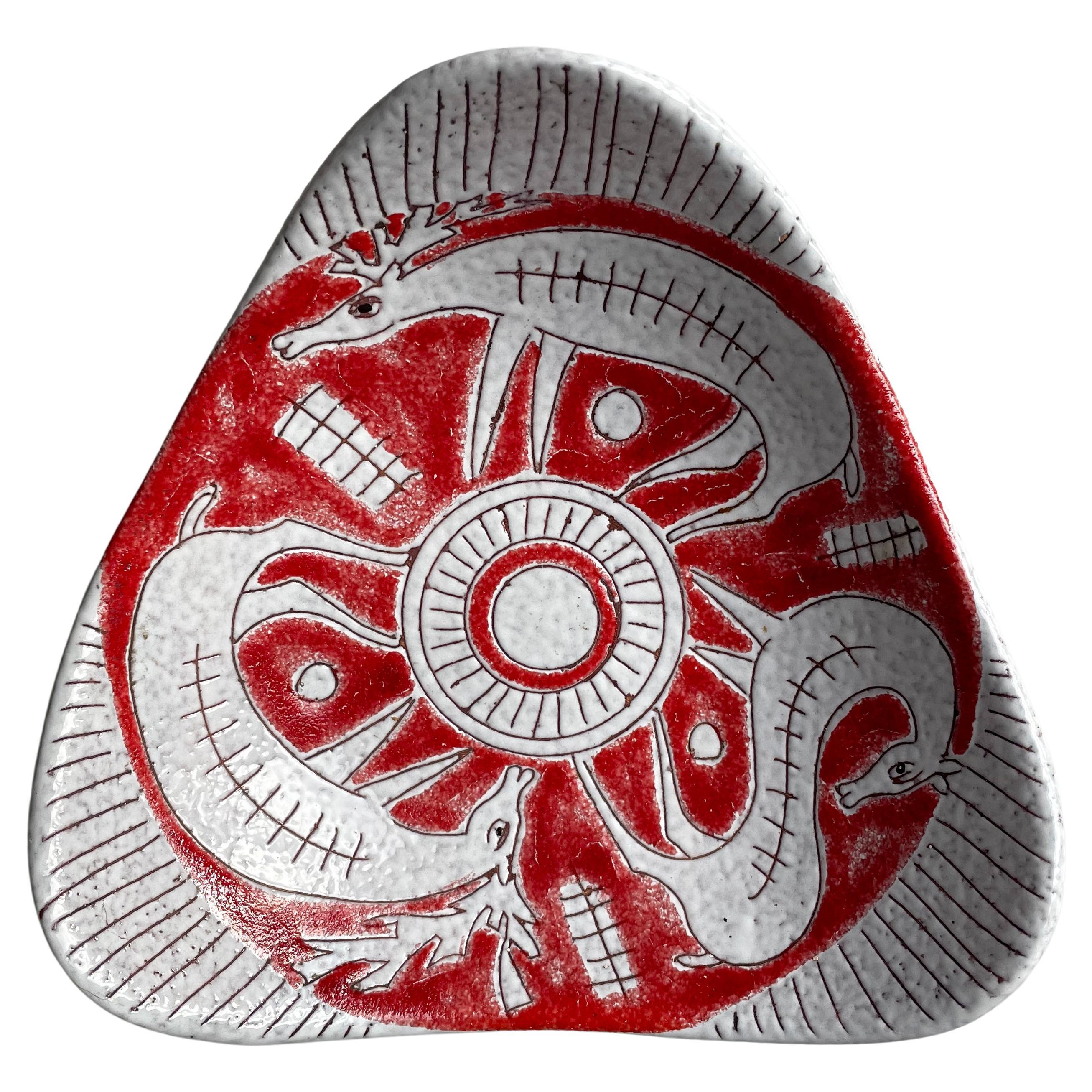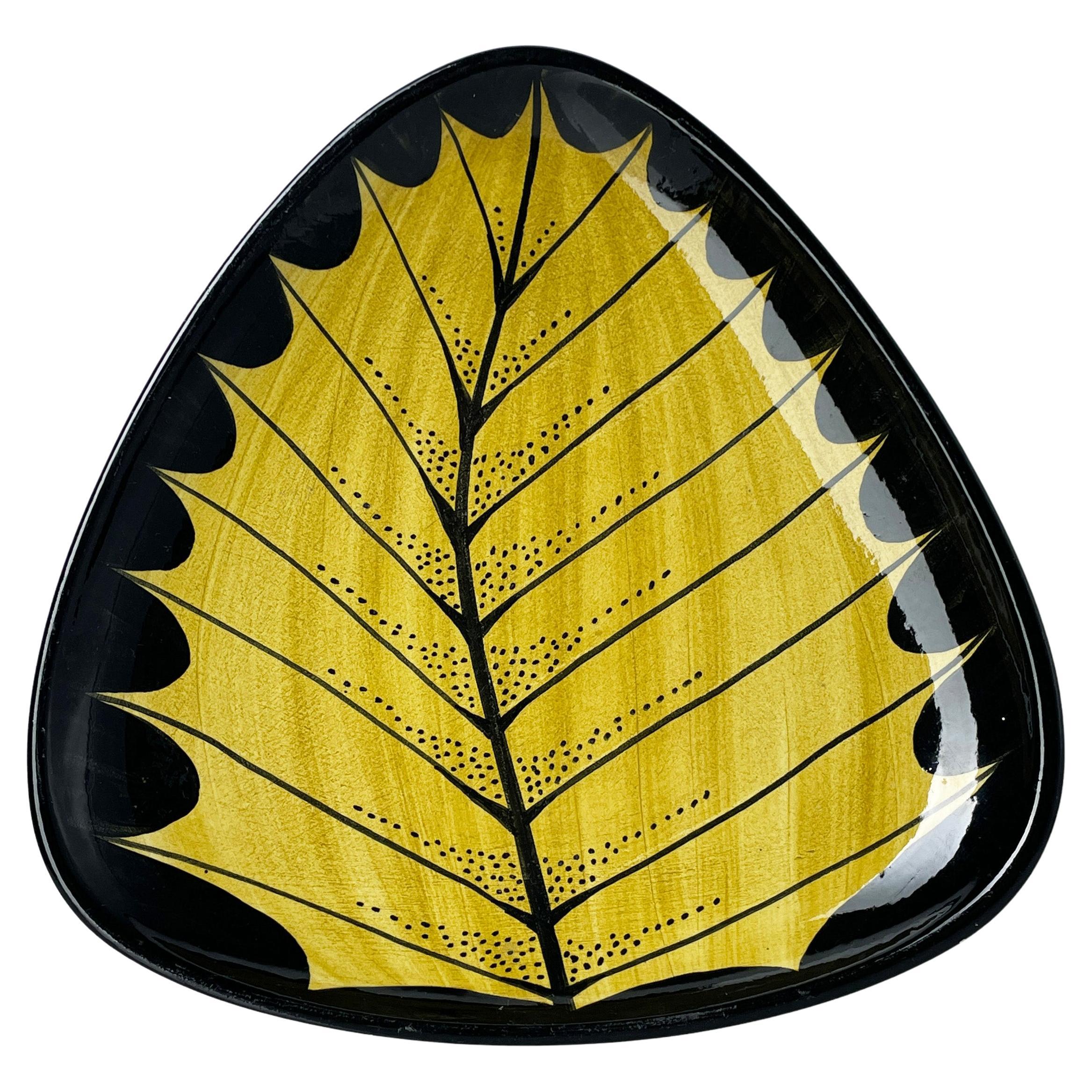Items Similar to Lívia Gorka Decorative Ceramic Bowl, Hungary ca 1960s
Want more images or videos?
Request additional images or videos from the seller
1 of 8
Lívia Gorka Decorative Ceramic Bowl, Hungary ca 1960s
About the Item
Munkácsy Mihály Prize-winning Hungarian ceramicist, worthy artist, and daughter of Géza Gorka, Gorka Lívia is one of the most renowned Hungarian ceramists. Her present work is a highly distinctive piece even if measured against her own exceptional repertoire.
In 1947, Lívia Gorka passed her master's exam in pottery. Her master was his father, Géza Gorka. As an independent, self-employed artist, se worked in the Gorka workshop in Verőce until 1959, and had created in her own studio after that. The source of her art has always been nature, and as such, her typical objects (if we can discuss typical at all in her case) are large, asymmetrical vessels, idols, fish, birds, and stones. Gorka preferred creating unique objects and to think in series and groups of objects. She worked with high-fired, custom-made materials such as stone, oxide clay glazes, and often combined clay with metal. The colours of her works have a strong plastic effect and are generally quite restrained. This handmade piece reflects her minimalistic and timeless language of forms that appears in every inch of this bowl that is in the field between art, design, and handicraft. The colours are spectacular, the black glazed outside harbours a medley of shapes and colours on the inside. This glazed, geometrically decorated piece has an unusual, modern shape with a hollow opening on top. The bright orange line traces the shape to the hollow opening towards the top and articulates the unusual angle at which the bowl stands. Lívia Gorka was able to step out of her father's shadow and create her own style with her ceramics. A true artist who always worked with craft techniques, she also developed her own technique for making the glaze, so her works, like this bowl, always represent a recognizable, unique world of shapes and colours.
Gorka was a master of these subtleties that established her one-of-a-kind visual language that is still coveted not just in her native Hungary, but all around the world among ceramic enthusiasts and collectors. Thanks to this, it can easily be placed in both a vintage or contemporary interior and is sure to stand out from its surroundings.
About the designer:
Gorka Lívia (Nógrádverőce March 5, 1925 – Diszel, August 4, 2011) Mihály Munkácsy Prize-winning Hungarian ceramicist, a distinguished artist. Daughter of Géza Gorka.
She was born in Nógrádverőce to Géza Gorka and Irén Kovács. She received her professional and artistic training in her father's workshop. She got used to serious work when he was six or eight years old, as she worked in his father's workshop during school breaks. She had gained additional knowledge during self-education and travels abroad (Finland). In 1948, she passed the master's examination for pottery. In her opinion, his father: "He had a legendary knowledge of materials. He worked with accumulated experience and intuition. He had everything in his hands. I could only infer his working method." She worked in the Gorka workshop in Verőce until 1954, so she had someone to learn the hidden secrets of the profession from. From 1954 she created in her own workshop, and from 1962 in Budapest.
He also mixes stone, metal and ceramics. Lívia Gorka's works are mostly separated from their practical functions, and as independent sculptures they represent the versatile possibilities inherent in the ceramic genre. (His public works: in Gödöllő: Zodiákus, 1966; at the University of Agricultural Sciences, at the hospital in Tatabánya: Under the Magnifying Glass, 1979 and Birds in 1975 at the Hungarian Embassy in Washington.)
The source of his art is nature, his typical objects are large, asymmetrical vessels, idols, fish, birds, and stones. It followed the ancient brain formation before pucks. He created unique objects, he liked to think in series and groups of objects. "I love my job. I absolutely love working for myself. I like the freedom and order of the small workshop. Simply because I am responsible for everything from the beginning to the end, I have something to do with the good and the bad. Giving shape to the formless greyness: I create from nothing, sometimes I feel like it. In addition to respecting and following the old "greats", it is possible to get to know the origin and properties of new materials by hand and in fire."
From 1994, the permanent exhibition of the Gorka Museum in Verőce was expanded with material from Géza Gorka's daughter, Lívia, and her late husband, Géza Gorka-Focht, so visitors can learn about the art of the famous ceramic dynasty in one museum.
She was a member of the Association of Hungarian Artists and Industrial Artists (MKISZ) from 1956, the Art Fund, the National Association of Hungarian Artists (MAOE) from 1955, and the Association Internationale de la Couleur (AIC), and from 1970- to the International Handicrafts Group.
- Creator:Livia Gorka (Artist)
- Dimensions:Height: 7.88 in (20 cm)Width: 7.68 in (19.5 cm)Depth: 3.55 in (9 cm)
- Style:Mid-Century Modern (In the Style Of)
- Materials and Techniques:Ceramic,Glazed
- Place of Origin:
- Period:
- Date of Manufacture:1960s
- Condition:Wear consistent with age and use.
- Seller Location:Budapest, HU
- Reference Number:1stDibs: LU9486237577892
About the Seller
New to 1stDibs
Joined in the past six months.
No Reviews Yet
Vetted Seller
These experienced sellers undergo a comprehensive evaluation by our team of in-house experts.
1stDibs seller since 2023
- ShippingRetrieving quote...Ships From: Budapest, Hungary
- Return PolicyA return for this item may be initiated within 14 days of delivery.
More From This SellerView All
- Søren Georg Jensen Teak Coffee Table for Kubus, Denmark 1960sBy Søren Georg JensenLocated in Budapest, HUThis Danish mid-century modern teak coffee table was designed by the Danish designer, Søren Georg Jensen and produced by Kubus. The design is sculpturally distinctive with intertwini...Category
Vintage 1960s Danish Mid-Century Modern Coffee and Cocktail Tables
MaterialsTeak
- Adrian Pearsall "2315-C" Lounge Chairs for Craft Associates, USA 1960sBy Adrian PearsallLocated in Budapest, HUAdrian Pearsall was born in 1925 in Trumansburg, New York. Like many Mid-Century Modern artists of the time, Pearsall was a graduate of architecture school. This background is profou...Category
Vintage 1960s American Mid-Century Modern Lounge Chairs
MaterialsBouclé, Wood
- Radák Eszter "Stipistopi, a középső én vagyok!" Oil Painting, Hungary 2013By Eszter RadákLocated in Budapest, HUHungarian painter and artist Radák Eszter is a vibrant force in the contemporary art world, known for her mesmerizing use of colours and bold artistic expressions. With a career span...Category
2010s Hungarian Modern Contemporary Art
MaterialsCanvas
- Danish Cabinetmaker Triangular Coffee Table With Tapered Tripod Legs, Denmark caLocated in Budapest, HUassociate Danish furniture design with the country’s golden age, the mid-twentieth century. This simple, yet beautifully designed and executed side table shows why this is. This mid...Category
Vintage 1960s Danish Mid-Century Modern Side Tables
MaterialsWood
- European Mid-Century Wooden Stools with Hand-Carved Scoop Seats, Europe ca 1950sLocated in Budapest, HUThe design of this European stool is characterized by a minimal, clean approach that seeks to combine functionality with beauty. Its focus is on simple lines and light spaces, devoid...Category
Mid-20th Century European Folk Art Stools
MaterialsWood
- VEB Leuchtenbau Model "7204" Table Lamp, Germany 1950sBy VEB LeuchtenLocated in Budapest, HUThe "7204" lamp designed in the late 1950s at VEB Leuchtenbau is a classic example of mid-20th-century German design and craftsmanship. Manufactured by...Category
Vintage 1950s German Mid-Century Modern Table Lamps
MaterialsMetal, Brass
You May Also Like
- Livia Gorka VaseBy Livia GorkaLocated in New York, NYThe ceramic work of Livia Gorka stands out as truly unique and special, bearing the hallmark of her masterful craftsmanship, deep connection to nature, and innovative approach to po...Category
Vintage 1950s Hungarian Ceramics
MaterialsCeramic
- Italian Ceramic Bowl Ca' 1960'sBy BitossiLocated in St.Petersburg, FLSuper mod 1960's, Italian ceramic bowl. Made by SICA-in Vicenza, Italy. Great colors-very thick and heavy. Unusual line decoration.Category
Vintage 1960s Italian Mid-Century Modern Ceramics
MaterialsCeramic
- Beate Kuhn Abstract Ceramic Bowl 1960sBy Beate KuhnLocated in Munich, DEWonderful early work of the famous German ceramic Artist Beate Kuhn from the 1960s. The bowl is designed in red, white and black glazed ceramic with an abstract forms. Artist signatu...Category
Vintage 1960s German Mid-Century Modern Ceramics
MaterialsCeramic
- Fratelli Fanciullacci Red White Organic Decorative Bowl, 1960sLocated in Copenhagen, DKVintage Italian modernist soft shaped triangular decorative bowl / wall plate by Fratelli Fancuillacci, late 1950s-early 1960s. Three stylized deer on ea...Category
Mid-20th Century Italian Mid-Century Modern Decorative Bowls
MaterialsCeramic
- Very Rare Hungarian Ceramic Sculpture of a Mother and Child, 1960sLocated in Nürnberg, BayernVery rare Hungarian ceramic sculpture Mother with child, 1960s. Stamped and signed.Category
Vintage 1960s Hungarian Mid-Century Modern Ceramics
MaterialsCeramic
- 1950's Decorative Ceramic Plate / BowlLocated in Bern, CHDecorative triangular shaped ceramic bowl / plate produced in the late 1950's to mid 1960s. Features a bold yellow and black leaf pattern. Maufacturer's mark on base: 4022 3Category
Mid-20th Century German Mid-Century Modern Ceramics
MaterialsCeramic
Recently Viewed
View AllMore Ways To Browse
Small Fish Bowl
Cruche Terra Cotta
18th Century Ware
J Swan
Otto Klaesson
Eugene Pattarino Ceramic
Salt Glazed Ewer
Matt Green Pottery Mid Century
Rene Neveux
Roberto Lugo
Roger Capron Fish
Samuel Alcock Majolica
Scheier Ceramics
Tomato Pottery
Vintage Ceramic Egg Cup
18th C Wedgwood
Carat Gold And Black Decals
Johnson Brothers Wild Turkey





